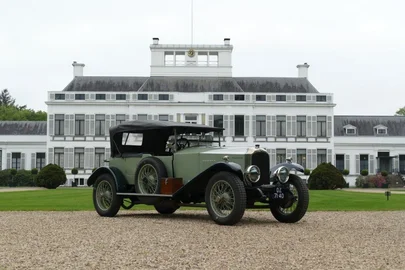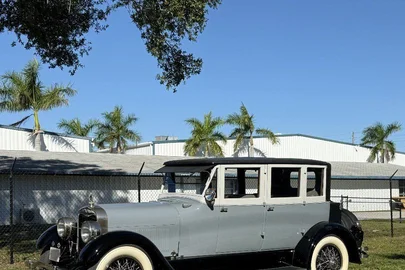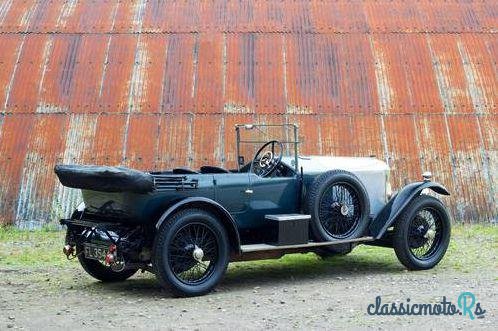
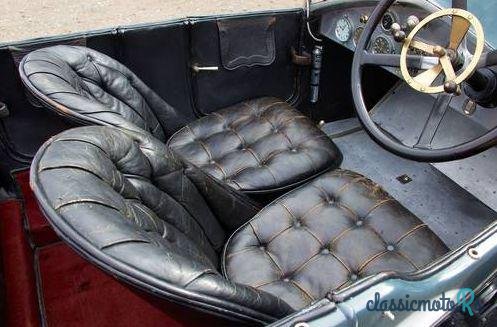

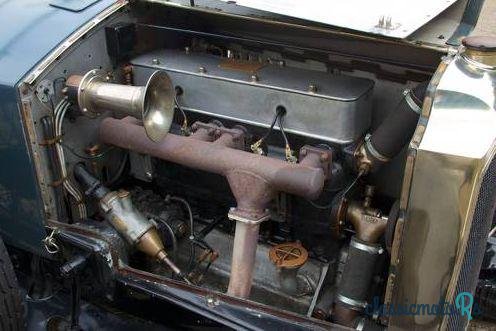
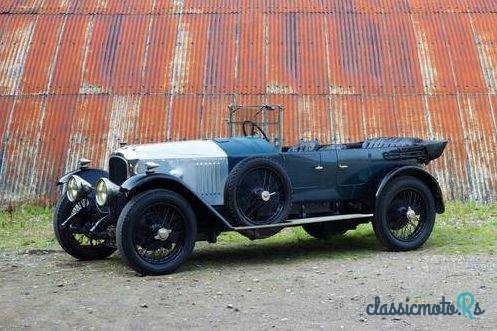
5 photos
1923' Vauxhall 30-98 Velox Tourer
Report This Ad!Rate This!Bookmark This
NegotiablePublished 13 January 2017ID: l08ogQ
Expired
8 years, 11 months ago
8 years, 11 months ago
Information from the owner
Body: Sports Car
Age: 94 years
Exterior color: Silver
Exterior: Tonneau Cover
Seller's comments about 1923' Vauxhall 30-98 Velox Tourer
The 30/98 Vauxhall was originally conceived in 1913 as a competition car and was built in two and four seater forms for hillclimbs as well as in single seater form for racing at Brooklands, both of which it did with such notable success that there was a clear demand for such a car. Rumours in the motoring press in 1914 speculated that the launch of a Super Sports Vauxhall was imminent, however the outbreak of war meant that production didn’t begin properly until 1919.
Based on a modified Prince Henry chassis, the 30/98 was distinguished from its predecessor by its flat radiator as opposed to the V-shaped radiators of the earlier models. The designer, Laurence Pomeroy took the L-head side-valve engine used in the Prince Henry and not only bored it out by 3mm but increased the stroke as well. The result of said modifications was a capacity increase from 4 to 4.5 litres, with power growing from an already respectable 75 bhp to a whopping 90 bhp. To put this into perspective, at the same time the Rolls-Royce Silver Ghost was producing 80 bhp using a 7.5 litre six-cylinder engine!
Potential customers had a choice of two factory bodies when they ordered their new Vauxhall 30/98. Velox was a factory four seater body that was lightweight in construction with an elegant design. The bonnet was finished in either polished aluminium or could be painted to match the rest of the car. For those who wanted an even sportier look there was the Wensum, a boat-tailed open two or three seater body that was described by Vauxhall as “an ultra-sporting body”. Of course, the option to order just the chassis and have the coachwork by your chosen coachbuilder was also an option.
The first 30-98’s all used E as the prefix to their chassis numbers, but in 1922 this was changed to OE with the introduction of a brand new engine design. Using the same foundations, the engine now featured overhead valves and a detachable head. The stroke was returned to its original Prince Henry length, reducing capacity to 4,224cc. Despite the reduction in capacity, the other modifications increased power by 30% to an incredible 115 bhp.
When production ceased in 1927 a total of 587 Vauxhall 30-98’s had been made. 274 of them were the earlier ‘E’ models and the other 313 being the later ‘OE’.
This stunning example, chassis number OE88 was first registered in March 1924. Little is known of the first three years of the cars life, however, it is reputed that the car took part in the Alpine Trial prior to 1927, however, there is no documentation to confirm this. The fabulous history file begins with an original headed letter from Vauxhall to a Mr. H.S Robinson dated October 1927. The letter is an acknowledgement that Mr. Robinson of Newcastle Upon Tyne was now the owner of OE88. The car would remain in his ownership through the war until 1950 at which point it was bought by Denis Aldridge, a Scottish hotel manager who a few years later became the manager of the famed Gleneagles Hotel. Aldridge, along with a couple of other Scottish 30-98 owners, became well known in VSCC circles for driving their cars south of the border, winning races and hillclimbs, before returning to Scotland with the silverware. As a result, OE88 and the other 30-98’s involved are known as the ‘Scottish Raids’ cars.
With a thirst for VSCC success and to make the best of his beloved Vauxhall, Aldridge chose Herbert Niven, a hugely respected Glasgow based specialist, to maintain and modify OE88. With performance in mind, the following modifications were made: Compression increased to 6.5:1, Hardy-Spicer propshaft, modified cylinder head with enlarged inlet valves and polished ports, constant mesh gears, counter balanced crank, scintilla magneto, lightened flightwheel and conversion to twin SU carburettors. With an already impressive set of performance statistics, this 30-98 really is a well sorted example and one can really appreciate these modifications on the road. Looking through the numerous letters and correspondence in the history file, Denis Aldridge was clearly a much respected 30-98 owner as a number of letters were written from other 30-98 owners asking for advice with similar modifications to their own motor cars.
In 1968, a Mr. Humphrey Milling came to Gleneagles for a golfing weekend and during his stay must have seen OE88 as a trail of correspondence follows his stay negotiating the purchase of the car, which he succeeded in, purchasing the car for £2,500 and driving it from Gleneagles all the back down to the South of England. Humphrey would own OE88 until his death in 2010 and judging by the history file that accompanies the car, he was an extremely fastidious owner and an excellent keeper of records as we have a huge number of invoices dating right back to 1968. During his ownership a number of major mechanical works were carried out, including a full rebuild of the entire braking system to hydraulic specification. In 1978 the decision was made to completely restore the car which included a bare metal respray in Masons Blue-Grey , a full retrim of the interior trim along with a new double Wigan hood, hood bag and tonneau cover. Templeton Engineering were tasked with the mechanical side of the restoration and must have more than impressed Mr. Milling as they looked after the car from the late 70’s until 2010.
Upon his death in 2010 Mr. Milling’s beloved 30-98 passed to his widow and it was soon afterwards that the current owner (the 4th in the cars history!) acquired OE88. During his ownership the car has been used on various rallies including the Gordon Bennett and Flying Scotsman.
Today OE88 is presented as it was restored in 1978 with Masons Blue-Grey coachwork, black wings, black trim and carpets and a polished bonnet. Cosmetically the car presents perfectly as an older restoration with a sumptuous level of patina to the paint and trim accompanied by wonderfully maintained mechanicals.
Based on a modified Prince Henry chassis, the 30/98 was distinguished from its predecessor by its flat radiator as opposed to the V-shaped radiators of the earlier models. The designer, Laurence Pomeroy took the L-head side-valve engine used in the Prince Henry and not only bored it out by 3mm but increased the stroke as well. The result of said modifications was a capacity increase from 4 to 4.5 litres, with power growing from an already respectable 75 bhp to a whopping 90 bhp. To put this into perspective, at the same time the Rolls-Royce Silver Ghost was producing 80 bhp using a 7.5 litre six-cylinder engine!
Potential customers had a choice of two factory bodies when they ordered their new Vauxhall 30/98. Velox was a factory four seater body that was lightweight in construction with an elegant design. The bonnet was finished in either polished aluminium or could be painted to match the rest of the car. For those who wanted an even sportier look there was the Wensum, a boat-tailed open two or three seater body that was described by Vauxhall as “an ultra-sporting body”. Of course, the option to order just the chassis and have the coachwork by your chosen coachbuilder was also an option.
The first 30-98’s all used E as the prefix to their chassis numbers, but in 1922 this was changed to OE with the introduction of a brand new engine design. Using the same foundations, the engine now featured overhead valves and a detachable head. The stroke was returned to its original Prince Henry length, reducing capacity to 4,224cc. Despite the reduction in capacity, the other modifications increased power by 30% to an incredible 115 bhp.
When production ceased in 1927 a total of 587 Vauxhall 30-98’s had been made. 274 of them were the earlier ‘E’ models and the other 313 being the later ‘OE’.
This stunning example, chassis number OE88 was first registered in March 1924. Little is known of the first three years of the cars life, however, it is reputed that the car took part in the Alpine Trial prior to 1927, however, there is no documentation to confirm this. The fabulous history file begins with an original headed letter from Vauxhall to a Mr. H.S Robinson dated October 1927. The letter is an acknowledgement that Mr. Robinson of Newcastle Upon Tyne was now the owner of OE88. The car would remain in his ownership through the war until 1950 at which point it was bought by Denis Aldridge, a Scottish hotel manager who a few years later became the manager of the famed Gleneagles Hotel. Aldridge, along with a couple of other Scottish 30-98 owners, became well known in VSCC circles for driving their cars south of the border, winning races and hillclimbs, before returning to Scotland with the silverware. As a result, OE88 and the other 30-98’s involved are known as the ‘Scottish Raids’ cars.
With a thirst for VSCC success and to make the best of his beloved Vauxhall, Aldridge chose Herbert Niven, a hugely respected Glasgow based specialist, to maintain and modify OE88. With performance in mind, the following modifications were made: Compression increased to 6.5:1, Hardy-Spicer propshaft, modified cylinder head with enlarged inlet valves and polished ports, constant mesh gears, counter balanced crank, scintilla magneto, lightened flightwheel and conversion to twin SU carburettors. With an already impressive set of performance statistics, this 30-98 really is a well sorted example and one can really appreciate these modifications on the road. Looking through the numerous letters and correspondence in the history file, Denis Aldridge was clearly a much respected 30-98 owner as a number of letters were written from other 30-98 owners asking for advice with similar modifications to their own motor cars.
In 1968, a Mr. Humphrey Milling came to Gleneagles for a golfing weekend and during his stay must have seen OE88 as a trail of correspondence follows his stay negotiating the purchase of the car, which he succeeded in, purchasing the car for £2,500 and driving it from Gleneagles all the back down to the South of England. Humphrey would own OE88 until his death in 2010 and judging by the history file that accompanies the car, he was an extremely fastidious owner and an excellent keeper of records as we have a huge number of invoices dating right back to 1968. During his ownership a number of major mechanical works were carried out, including a full rebuild of the entire braking system to hydraulic specification. In 1978 the decision was made to completely restore the car which included a bare metal respray in Masons Blue-Grey , a full retrim of the interior trim along with a new double Wigan hood, hood bag and tonneau cover. Templeton Engineering were tasked with the mechanical side of the restoration and must have more than impressed Mr. Milling as they looked after the car from the late 70’s until 2010.
Upon his death in 2010 Mr. Milling’s beloved 30-98 passed to his widow and it was soon afterwards that the current owner (the 4th in the cars history!) acquired OE88. During his ownership the car has been used on various rallies including the Gordon Bennett and Flying Scotsman.
Today OE88 is presented as it was restored in 1978 with Masons Blue-Grey coachwork, black wings, black trim and carpets and a polished bonnet. Cosmetically the car presents perfectly as an older restoration with a sumptuous level of patina to the paint and trim accompanied by wonderfully maintained mechanicals.
